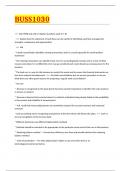Exam (elaborations)
BUSS1030 ) (Solved Questions 100% VERIFIED QUESTIONS AND ANSWERS)
- Course
- Institution
>>> (do MYOB and end of chapter questions week 6,7, 8) >>> Explain how the statement of cash flows can be useful for identifying cash flow management strengths, weaknesses and opportunities >>> Wh * A bank reconciliation identifies missing transactions and it is...
[Show more]



